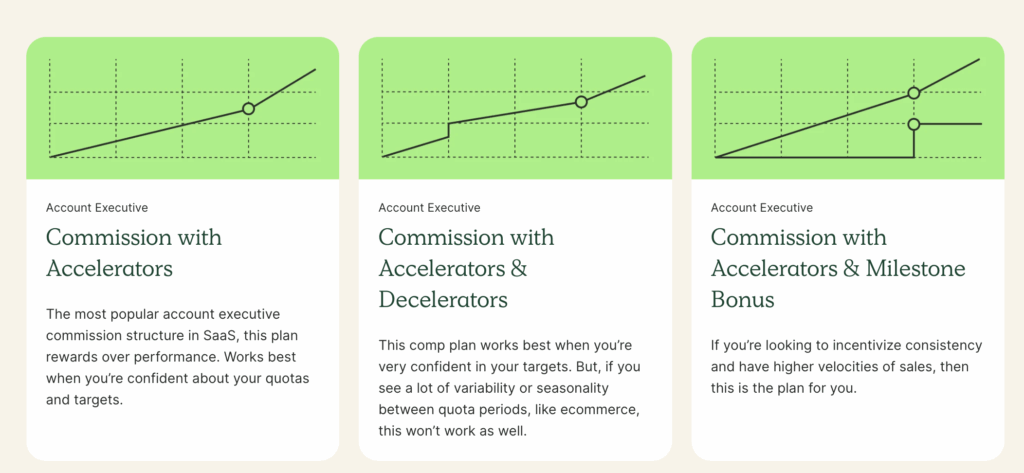If you’ve ever built or managed a SaaS sales comp plan, you know the stakes are high.
A well-structured plan can fuel growth, align GTM teams, and retain top talent.
But too often, compensation plans become bloated, confusing, or misaligned with what actually drives your business forward. At QuotaPath, we believe the best sales comp plans are simple, logical, and fair—and that they’re tailored to how your team sells and scaled as your business grows.
In this guide, we break down proven SaaS sales compensation models by sales motion and role, highlight when to use each, and share best practices to ensure your plans motivate performance and scale with clarity.
Whether you’re a startup drafting your first AE plan or a growth-stage company evolving toward PLG and NRR-based models, this blog offers actionable templates and guidance to get comp right.
Step 1: Understand What Makes a SaaS Compensation Plan Successful
Simplicity, Logic, and Fairness
First, there are three key attributes of an effective SaaS sales comp structure: simplicity, logic, and fairness.
Simplicity, in the context of sales compensation, refers to a plan that is easy to administer and for the sales team to understand and calculate. To accomplish this, we recommend using no more than three compensation components per plan. HubSpot’s sales compensation structure provides several examples of simplicity in a SaaS sales comp structure.
Logic ensures that the compensation plan accurately reflects the company’s goals and motivates the sales team to achieve them. To create a logical compensation plan, align your plans with business goals by rewarding behaviors that drive business objectives.
Fairness means considering factors like rep performance, role, contributions, territory, and market standards when building a sales compensation plan. Then ensure quotas and OTEs are realistic and attainable.
Use this checklist to evaluate if a current plan meets these principles:
- Simple: No more than three compensation components per plan
- Logical: Plan aligns with business goals and rewards behaviors that drive key business objectives
- Fair: Quotas and OTEs are realistic and attainable
Calculate OTE:Quota ratios
Use this free calculator to ensure your reps’ on-target earnings and quotas mirror what they’re bringing in for the business.
Try it NowStep 2: Choose the Right Plan Based on Your Sales Motion
Second, as you approach building your comp plans, the next step is selecting a B2B SaaS commission model according to how your team sells. Aligning incentives with desired outcomes is essential to motivating software sales teams and driving business success.
Revenue-Based Plans
A revenue-based compensation plan is a SaaS sales comp structure where a salesperson’s earnings are tied to the revenue generated by their closed deals or sales activities. It aligns sales incentives with the company’s business objectives to motivate behaviors that drive goal achievement.
- Single Rate Commission: An easy-to-understand plan that pays the same rate on every deal. This is an excellent “first” Account Executive plan for a startup, or a company expanding into a new territory, or launching a new product or service.
- Multiple Rate Bonus: offers a higher bonus amount for quota attainment or meeting criteria such as closing a specified number of deals in the predetermined period. This plan is intended to motivate and reward Account Executives who navigate high seasonality and adjusted quotas throughout the year.
- Net Revenue Retention (NRR): A plan that incentivizes Account Managers at a scaled company to expand existing accounts through upselling or to increase product adoption in PLG models.
- Gross Revenue Retention: Incentivizes Account Managers to focus on customer retention when upsell and expansion opportunities are limited in early-stage businesses.
RevOps, sales leaders, and finance teams use our free tool to ensure reps’ on-target earnings and quotas line up with industry standards. Customize plans with accelerators, bonuses, and more, by adjusting 9 variables.
Build a Comp PlanCommission + Bonus Models
These SaaS sales comp structure types include a mix of variable pay tied to individual sales performance, plus additional bonuses for achieving specific goals or milestones. This approach is excellent for motivating software sales teams to close deals while incentivizing reps to achieve broader company objectives.
- Accelerators: Incentives paid for exceeding sales goals, designed to motivate sales reps to sell more products or services by offering a bonus or other reward for achieving specific milestones, like 100% quota attainment. Accelerators encourage overperformance and are commonly included in a SaaS sales comp structure.
- Milestone Bonus: A set amount paid when a rep meets pre-determined stipulations. The payment criteria for these bonuses are straightforward. Reps only earn the bonus when they meet or exceed the stipulated goal. Otherwise, they receive nothing. This can lead to sandbagging, so we recommend pairing a milestone bonus with a commission plan to minimize this issue.
- Cliff: The minimum sales level a rep must achieve before they qualify to earn commissions according to the sales incentive plan. Also known as a commission floor, this compensation plan element can effectively motivate salespeople to attain designated key performance metrics.
Remember that to really see success with your comp plan model, regardless of the structure you move forward with, you have to provide your reps with visibility into their plans and progress. Enabling reps to track their progress with an application like QuotaPath keeps them motivated.
According to Genevieve of NeuroFlow, “The sales team loves having the ability to see their pipeline, forecast potential commissions, and understand exactly how payouts are calculated and when they’ll receive them.”
Usage-Based or Activity-Based Plans
The following are examples of comp plans for product-led growth or hybrid motions. “Despite the fundamental differences between traditional and usage-based pricing models, the underlying principles of sales compensation remain consistent. Both models involve determining the optimal balance between base pay and variable compensation, aiming to motivate sales reps to drive revenue growth,” Graham Collins said.
- Usage-Based: Reward salespeople based on the volume or value of product or service their customers consume, naturally aligning with a product-led growth (PLG) motion. This B2B SaaS commission model encourages sales reps to focus on long-term customer success and expansion.
“By correlating sales compensation directly to customer usage, companies can foster a customer-centric sales culture and drive sustainable revenue growth,” according to Graham Collins. - Activity-Based: Rewards salespeople for completing specific sales activities, such as making calls, setting appointments, or sending proposals, and is designed to motivate sales reps to prioritize activities that lead to closed deals. Align sales incentives with user engagement, product adoption, and value realization instead of closed deals or upfront revenue with a PLG motion.
Example: “Pay reps $100 for every product-qualified lead (PQL) converted.”
Design, track, and manage variable incentives with QuotaPath. Give your RevOps, finance, and sales teams transparency into sales compensation.
Talk to SalesStep 3: Align Plans with Roles on Your Team
Next, you have to match the plans to the roles of your team.
Each sales role has distinct responsibilities and contributions in the sales process. Tailoring compensation to roles ensures incentives are relevant and effective for motivating software sales teams’ performance, driving desired behaviors, and achieving business goals.
For New Business Reps (SDRs, BDRs)
Activity-based plans encourage new business reps to complete desired activities aligned with organizational goal achievement.
- Activity-based pay: Rewards salespeople for performing specific sales activities, such as demos booked, calls made, or new qualified opportunities created. For instance, a new business rep earns $50 per qualified meeting they schedule, plus $200 per sales qualified lead (SQL). This encourages reps to focus on prospects aligned with prospects who match buyer personas most likely to purchase your product or service.
- Activity Based + Closed Won Commission: Adding a closed/won commission encourages new business reps to engage with quality leads by rewarding them with a percentage of every opportunity they create that results in a purchase. For example, using the Qualified Opportunity Bonus + Close Won Commission plan a rep could earn $100 for each opportunity generated plus a 2% commission for each closed/won deal.

For Account Executives
Select a SaaS quota-based compensation plan designed to motivate account executives to prioritize deals that drive business goals and encourage overperformance.
- Commission with Accelerators: A tiered commission structure, commonly adopted by SaaS businesses, designed to reward overperformance by enabling reps to earn a higher percentage on sales closed once they hit quota.
- Commission with Accelerators and Decelerators: A three-tiered B2B SaaS commission model for organizations selling products that are unaffected by seasonal shifts in buyer behavior. This plan includes accelerators for motivating software sales teams to overperform, decelerators for demotivating poor performance by discouraging reps from closing less profitable deals.
- Commission with Multi-Year Accelerators: Incentivizes reps for exceeding quota and for selling multi-year contracts. For example, an account executive on this plan earns a 10% commission of 1-year deals they close, 15% of 2-year deals, and 20% of 3-year deals.
For Customer Success & Renewals
Customer success and account managers typically handle renewals and expansions. The SaaS sales comp structure you select for your team should align with your current goals and priorities.
- GRR-Based: This plan keeps account managers focused on customer retention. It is well suited for companies with consistent pricing and minimal upsell or expansion opportunities.
- NRR-based: An NRR-focused compensation plan makes most sense for scaled organizations or those with product-led growth (PLG) strategies. This model incentivizes account managers to grow their existing book of business rather than retaining every customer, and it is well-suited for organizations with product-led growth strategies or ones that are scaled.
- GRR and NRR: This SaaS sales comp structure encourages account managers to balance their attention between retention and upsells and expansion, often evenly splitting the variable components 50/50 between GRR and NRR. For instance, account managers might receive a 2% bonus on expansion revenue after their retention threshold is met.
Step 4: Build a Scalable, Transparent Comp Plan
Lastly, build a plan that can scale. Specifically, one that can scale without sacrificing clarity.
Here are a few best practices to help with your sales compensation planning. A scalable comp plan starts with simplicity and alignment to company goals. Keep plans short, clear, and easy to explain. As AJ Bruno, QuotaPath’s CEO, puts it: “Plans should be so simple that someone could explain it to you in about 15 seconds.”
Set realistic quotas, introduce plans before the new year, and ensure reps understand how and when they get paid.
These fundamentals connect teams across sales, RevOps, finance, and leadership. Transparency is just as critical. Clear commission rules and real-time visibility build trust, drive retention, and reduce confusion.
“The whole reason we bought a platform was because we’re scaling,” said David Taub, Senior Director of Revenue Operations at Hydrocorp. “As I see more things rolled out, there’s more functionality I can continue to put into QuotaPath… it just gives a singular place for everybody to go get compensation truth and transparency.”
Tools like QuotaPath, integrated with your CRM, help automate this process, eliminate errors, and ensure every rep can track earnings in real time.
Try the most collaborative solution to manage, track and payout variable compensation. Calculate commissions and pay your team accurately, and on time.
Start TrialTry Pre-Built Compensation Templates with QuotaPath
Not sure where to start? QuotaPath’s Compensation Plan Library offers dozens of pre-built SaaS compensation plans that match a variety of sales motions and roles. You can also create and customize plans quickly with our AI-Powered Plan Builder, helping you save time and reduce errors.
Want to see it in action? Book a demo with our team to explore how QuotaPath can streamline comp planning and improve payout transparency.



